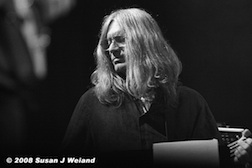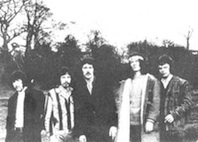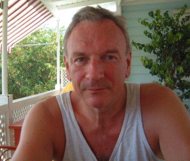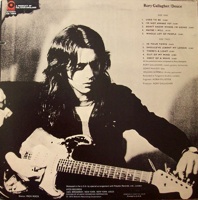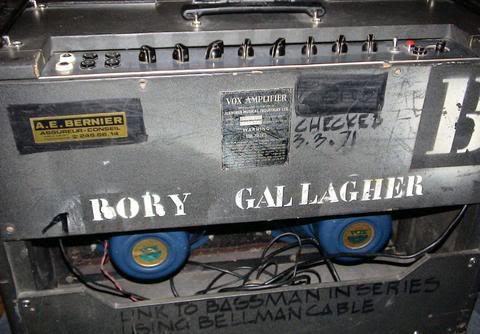May 13 2011
Rory Days: An interview with Robin Sylvester — Part 3
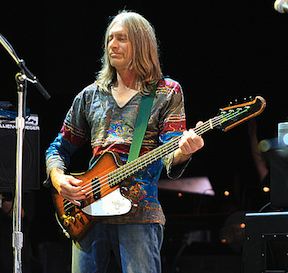
Robin Sylvester, bass player for Bob Weir’s band, Rat Dog, has been a fixture of the San Francisco music scene for so many years that one might understandably forget his substantial musical accomplishments in his own native England. In the late sixties, as the British Blues explosion rocked the pubs, clubs and concert halls of London Town, Robin was one of those lucky sods who witnessed it all, and much like his American counterparts who descended upon Yasgur’s farm in the summer of ’69, he can legitimately point to those heady times and say, “Yes, I was there!”
Born in 1950 Post War London, Robin spent much of his youth singing with the London Boy Singers, a professional boys’ choir patronized by distinguished composer Benjamin Britten. The choir performed regularly at Covent Gardens, and even made an album of Christmas music at famed Abbey Road Studios. Although now primarily known as a bass player, Robin also plays keyboard and guitar. By the time he turned 15 he was playing double bass in a Jazz band called, the David Lund Trio, and then later, the folk-rock band ORA. In 1969 he started working as chief engineer at London’s Tangerine Studios, and for the next 5 years worked closely with some of the finest up and coming Jazz, Progressive Rock, and Blues bands of Great Britain — none finer, at least in this writer’s view, than Ireland’s favorite son, Rory Gallagher.
Recently, I had a chance to ask Robin about those heady times in London where he witnessed first hand the great British Blues & Rock explosion — attending incredible shows at famed nightspots like the London Marquee, and recording aspiring musicians at Tangerine Studios. In Part Three of the interview, Robin talks about working with Rory on two of his live albums: Live in Europe, and Irish Tour ’74. You can read the previous parts of the interview here: Part 1 | Part 2
Part Three: Rory Gallagher Live
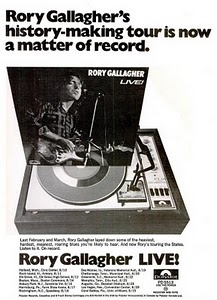
Shadowplays: So after Deuce we go from Rory attempting to record a “live” album in the studio to the truly live “Live in Europe”. This album charted well, making it to the top ten albums for the year. It was also Rory’s first “gold” album. You are listed as engineer along with Gerhard Henjes and Alan Perkins. Many of the tracks for the live album came from a gig at Luton Town Hall. In fact, Gerry McAvoy said it should have been called “Live at Luton”.
Robin Sylvester: Funny! And mostly true. By the time we had all the candidates mixed Rory wasn’t so concerned about location.
Shadowplays: What was your involvement with the albums production. Where you at some of these gigs in Germany, France and the U.K. where they were recorded? Any memories of those shows?
Robin Sylvester: We started listening to a load of live recordings Rory had gathered, – including many from Gerhard Henjes in Germany and Holland. Some were good, but did not convey the feeling he was after. By then we had a good understanding between us, so he set up the Pye Mobile Unit to record 3 shows (Luton, Nottingham & Leicester I’m almost certain). Lacking a producer, he designated me to co-ordinate things, which was easy with the professional crew and beautiful Neve studio-in-a-truck. The great Alan Perkins would have come with the truck, and probably did most of the real work on location! Bad traffic caused a tardy arrival in Nottingham, and I remember crawling all over the stage setting up while poor Nazareth were trying to do their opening set . . then it was guess the levels and, wham, right into a killer Messin’ With The Kid! Phew! . .the pressure! Luton was the best night, yes. (Opening band Genesis. . . I should have rolled tape!) We mixed a lot of tracks and refined the best to two <20 minute sections, and then it left my hands.
Shadowplays: Alan Perkins. He was also part of the famous 1970 Isle of Wight recording crew that filmed Murray Lerner’s documentary “Message to Love” . A nicely done documentary that includes a bit of Rory Gallagher and Taste’s 5-encore performance there. Hopefully one day all the footage of Taste that was filmed that day will be released on DVD!
So after listening to “Live in Europe” again, your impressions?
Robin Sylvester: I know we tried different ways to balance the 3-piece in the stereo picture. As I put on my original vinyl I am curious to see how we ended up.
. . . Strange to hear those tunes without piano! Seems like we went for the most natural balance, not worrying about the bass being a bit off-center as we knew it would be dragged central by the mastering process. We also went for the in-your-face guitar sound rather than blending in the sound of the concert hall. There was plenty of leakage on the vocal mike, anyway, – and this approach disguised that quite neatly. I would have hand-ridden the vocal in and out gently rather than use the crude noise-gate of the day. My original Polydor UK record sounds very good. No particular memories stirred except how straight-forward the whole process was: we mixed everything roughly and Rory chose his favorites, by then looking for specific tunes. Ahh! I love where he re-tunes his bottom string while singing on Laundromat! In Your Town sounds like the Strat with slide, which became more common.
I recall right at the very end we finished the sequencing in the middle of the night in some studio I’d never worked in before and worked very hard matching up levels and making the segues smooth. Much harder back then than it sounds nowadays!
Rory asked me what credit I thought was appropriate for me and I said: “Oh, something like remix engineer and mobile unit co-ordinator” – and that’s exactly what he put on the cover.
I enjoyed listening to that. I don’t have a cd yet, and my US Polydor from 1972 (called simply “Live”, no gatefold sleeve) sounds exactly the same except for the mastering job.
Shadowplays: Following “Live in Europe” came Blueprint along with the line-up change of Rod De’Ath replacing Wilgar Campbell on drums, and the addition of Lou Martin on keyboard, both from the band, Killing Floor. This time Phil Dunn and Andy Stephens handled the Engineer duties at the Marquee Studios. Had you left Tangerine Studios by then?
Robin Sylvester: No, I was stuck working my butt off at Tangerine for years, producing Byzantium in my spare time, etc. I would stay in touch and appear at Rory’s shows when I could. We never really discussed Blueprint. The Marquee was a superior studio by then, with 16-track, and that may have entered into the decision, along with the location. I visited during a remix session one day; we went for a drink at The Ship and ran into Brian May (waiting for his graveyard-shift session at Trident to start) He and Freddy often had to wait for the previous session to end, – sometimes it was my session! They would wait in the pub, but not drinking. Brian was nursing a liver problem anyway, I recall. I got to be a fly-on-the-wall during a detailed equipment discussion. (Rory swore by his VINTAGE treble-booster, and Brian had made his own copy of same!) Those were the days . . .
Shadowplays: Brian May — there’s a quote in one of the Rory biographies where Brian credits him for his sound.
I owe Rory my sound…I’d be the first to acknowledge a huge debt to the man. I wish he here to say that to, I really, really, wish he was here — Brian May.
After Blueprint came my two favorite Rory Gallagher albums, Tattoo and Irish Tour ’74. Tattoo was engineered by Carlos Olms. You did the remixes for Tattoo? This album had some great songs on it: Tattoo’d Lady, Cradle Rock, Who’s that Coming, A Million Miles Away. Just a classic Rory album. It also had a song on it that I thought was not your typical Rory Gallagher song, They Don’t Make Them Like You Anymore. That song has a big band, jazzy feel to it. I can see someone like Frank Sinatra singing that song! What did you think of the new line-up with Lou and Rod? The movement from a 3-piece to 4-piece band — having a guy on keys seemed to be popular back then.
Robin Sylvester: The band had recorded all the tracks at Polydor Records’ in-house studio, a very small 8-track room, and Rory called me in to see if I could help with the mixes. We used various studios and I have no idea where the finals came from, – even though I edited and sequenced it myself!! I don’t actually own the cd of Tattoo, and my vinyl sounds a little murky. I don’t remember doing anything radical, but mixing in the piano changed the perspective, and I frankly don’t think I quite got it right. Got Rory sounding big, though . . . The new band sounded great to me, but mostly I loved the new songs Rory was writing.
Shadowplays: Great songs, and the next album, Irish Tour ’74 perfectly captured many of those songs live. In my totally biased opinion, it’s the best live album ever! The recording of these live songs was done mostly using Ronnie Lane’s Mobile studio. Did you travel around on the LMS ? It was an airstream bus with a 16-track console. The Who used the LMS for the recording of Quadrophenia.
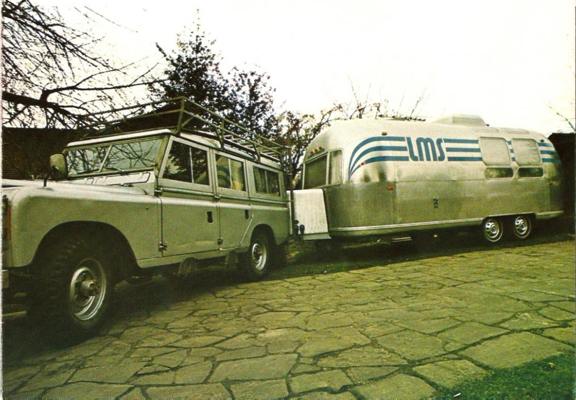
Tony Palmer was there also, taping a documentary about Rory and the band. So you’ve got 3 Venues, a sound crew and a film crew: it sounds like a logistical nightmare. Donal mentions that some of the tracks used on the album had to be recorded directly from the Tony Palmer’s film crew’s mixing deck because of a problem with the LMS not being able to travel to Belfast. Did the insurers consider Belfast too risky of a venue because of “the troubles” in Northern Ireland? Were there other complications
Robin Sylvester: Yes . . . what a to-do that was! I was booked to supervise recording the 3 Irish shows, and the Lane Mobile was booked. First snag: they only had one 16-track machine, and I wanted to run overlapping tapes so as not to interrupt the shows while we changed reels. Rory and I decided to go 8-track, since they had a second machine for that.
Second snag: The Mobile would not be making it to Belfast for various reasons and would meet us in Dublin. They had a rough crossing on the Irish Sea and we were still waiting for them during Thin Lizzy’s opening set. They arrived, but not in time to get anything usable except the acoustic tunes.
Third snag: the film unit, which was a surprise to me, needed a track for their synchronizing code. We had to go down to one track for the audience mikes! We also had to cross our fingers that Cork would be good . . . . and it was!! I traveled down from Dublin with Rory, Tony Palmer and cameraman. Rory good-naturedly larked around the Blarney Stone along the way.
The original record all came from our 7-track recordings except one acoustic tune, which we did take from the film sound-crew.
Shadowplays: You mentioned in a previous interview that side 4 of that double live album (Stompin’ Ground, Just A Little Bit) were bits and pieces from the sound check. Do you mean the sound check from the Cork City Hall show?
Robin Sylvester: We had 3 good sides and some fairly rough soundcheck jams from Cork. I made a lot of edits. mostly to give them more form. Pretty crude, really . . . but I used to love wielding the razor-blade!
Shadowplays: When the album was re-issued as a CD, “Just a Little Bit” was cut out and replaced with a 30-second snippet of “Maritime”. A shame really, “Just a Little Bit” rocked! Presumably this was done to condense the double album into one CD.
Robin Sylvester:Another reason they may have left off JUST A LITTLE BIT is the way we constructed it: we put sections together much like you would in Pro- Tools today, lots ofcopying and editing. The 8-track master was probably a real mess physically and a nightmare to try and mix! Sorry guys!
Shadowplays: Was there any more to “Maritime”? I’ve never heard any longer version of the instrumental. Was it something Rory did off the cuff in the studio? Or was it a complete song going in? The only info I’ve ever read was Donal’s notes about it being a dedication to Rory’s time at the Maritime Hotel in Belfast.
Robin Sylvester: MARITIME: We were constructing side 4 of IT74 in Tangerine studios out of very little material from the sound-check in Cork, and we loved this little piece of fun that lasted not much longer than the 30 seconds! Rory wasn’t sure it fitted in, but went for using it right at the end, with a quick fade. It was originally referred to as “The Edgar Lustgarten Story”, and it made Rory laugh to picture it playing over a foggy scene in an old black & white mystery movie!! That’s the whole story!!
Shadowplays: Edgar Lustgarten. He was the British version of Jack Webb, right? The Tornados did the theme to Lustgarten’s tv crime drama,“Scales of Justice”. Similar to the sound Rory was going for in Maritime, don’t you think?
Robin Sylvester: Rory’s “Edgar Lustgarten” reference was more likely The Shadows than the Tornadoes – but who knows! Edgar used to present low budget murder mysteries on late-night TV; his delivery was maybe even more wooden than Jack Webb’s!!.
Shadowplays: Ah the Shadows! I guess it would be much more likely Rory referencing the Shadows. I thought it was so cool the way the Shadow’s guitarists would all line up like an attacking army and play note for note. I don’t think they ever made it big here in the States despite their overwhelming popularity in England. I remember trying to learn to play “Apache” when I was a kid, though it might have been the Ventures version of it! Rory mentioned Hank Marvin quite a lot in interviews. In fact, I think Rory got his famous stratocaster because some showband guitarist thought he had ordered a solid red stratocaster like the one Hank used but instead got a red sunburst and returned it. Rory saw it at Crowley’s Music Store and had to have it. The rest is history!
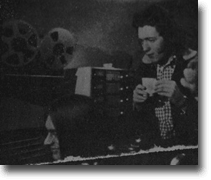
Shadowplays: Rory seemed wedded to that strat. Any remembered jams between you guys in the studios, the kind of tunes played, etc?
Robin Sylvester: Well, his guitar was always around, and Tangerine, at least, had a nice piano and B3. We never played what you might call real tunes; mostly we were just killing a few minutes to clear our heads or waiting for Donal to come back with the food! He was happy for me to play the guitar, but I was too shy in front of him to play anything serious!
Shadowplays: In Gerry McAvoy’s autobiography, Riding Shotgun, he talks about a late night gathering with some of “The Dubliners” at the Gresham in Dublin, and a jam at the Cork Rowing House, and some hi-jinks at the Metropole Hotel during the taping of the Irish Tour. Were you in on any of this?
Robin Sylvester: I was there for all the things you mention, actually! The backstage entourage [for the Dublin show] was huge and the party found its way to the hotel lobby where it lingered until dawn. Plenty of drinking, of course, but it was a pleasant scene of camaraderie, none of the drugs and girl-chasing I have seen plenty of with other bands. Luke (Dubliners banjo player) came back to the Gresham along with some other locals, and we all took advantage of hotel licensing laws until the dawn, at which point Luke headed for the docks where he knew a pub that was just opening! We were all a bit shaky the next day, and I woke up with almost no voice. This made my job harder as I could not shout instructions through the talkback to the stage. Consequently I did most of the set-up myself, including that atrocious duct-taping job on Rory’s mike. (We had to double-mike because there were no splitters . . . another surprise!!)
On the day of the show, when Rory and Donal picked me up at lunch-time, and after meeting their mother, they kindly agreed to show me a real Cork pub, where I could sample the local Murphys. We discussed the differences between room-temperature and cold, and I declined the traditional “Paddy’s while you wait for it to pour” that the bartender offered. It was a cheerful place, just the thing on a wintry Cork day.
As for the Metropole . . .I think Gerry and I were the guilty parties that night. Or at least, we were trying!
There was a great end-of-tour party at the Rowing House after the Cork show; but I was exhausted and had laryngitis and an early flight. Not that that would have slowed me down a lot back then . . .
IT74, ultimately, was a wonderful, magical, sleep-deprived few days of hard work and play in a strange land. I had a bad case of laryngitis and hangover and did my best amidst ever-changing circumstances. The mixes (back in London) were very straight-forward, and Side 4 (After Hours) was a fun experiment for Rory and me to use a little studio trickery for once.
End of Part Three
This ends Part Three of my interview with Robin Sylvester. In Part Four, Robin talks about working with Rory on his first album for Chrysalis — Against the Grain
